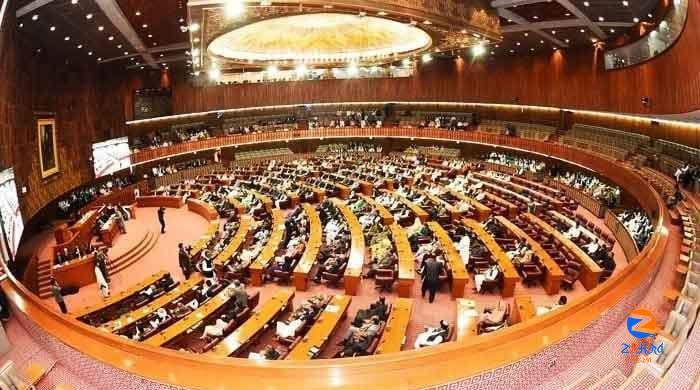
[ad_1]
As Pakistan’s 16th National Assembly completed its first 100 days since the oath-taking of lawmakers on February 29, its performance has been described as “slow-paced despite high attendance”.
A report published by the Free and Fair Election Network (Fafen) stated that the assembly was focused on “parliamentary transparency and gender responsiveness” — highlighting a hallmark feature of NA’s first 100 days.
It added that the House encouraged bipartisanship by allocating nearly 54% of the time used for points of order to the opposition.
Following the February 8 general elections, the Pakistani government fell into chaos as no political party won a clear majority. However, some of the winning parties allied with the Pakistan Muslim League-Nawaz (PML-N), backing a coalition government in the Centre.
The PML-N, therefore, formed the federal government with the support of eight parties, including the Pakistan Peoples Party Parliamentarians (PPPP), Muttahida Qaumi Movement-Pakistan (MQM-P), Pakistan Muslim League Qauid (PML-Q), Istehkam-e-Pakistan Party (IPP), Pakistan Muslim League Zia (PML-Z), Balochistan Awami Party (BAP) and the National Party (NP).
The House, however, still remains short of 26 members.
Plenary Proceedings
According to FAFEN, at least 23 sessions have been conducted in the lower house of the Parliament up until now, spanning over 66 hours and 33 minutes. The speaker and deputy speaker chaired 84% of the proceedings.
Prime Minister Shehbaz Sharif has, so far, attended only two sessions, which makes up 10% of his attendence as compared to former premier and Pakistan Tehreek-e-Insaf (PTI) founder Imran Khan’s 29% in the first 100 days of his ousted government.
Fafen added that the assembly elected its standing committee on May 17 after a month-long delay. In the first 100 days, only a money bill has been approved by the House.
Participation and Business
The Fafen report highlights that at least 159 members, or 51%, actively participated by sponsoring agenda items or participating in discussions out of the 310 members, 61% of which were females and 49% males.
On average, 230 members were present in one session, with a maximum attendance of 302 and a minimum of 176.
The House addressed 76% of its business, including 20 legislative bills, 93 questions, 28 calling attention notices (CANs), and 11 resolutions.
First Speech by Leader of the House
In his maiden speech, PM Shehbaz outlined his government’s plans for foreign relations, agriculture, economic affairs, tax reforms, energy, human development, and law and order, the Fafen report maintained.
Specific commitments, it added, included providing high-quality seeds to farmers, creating export zones, broad tax reforms, renewable energy projects, scholarships for students, and addressing terrorism as well as the issue of missing persons in Balochistan.
Transparency and Accessibility
The report underscored that the details from the assembly proceedings are available on the National Assembly’s website, but live streams or video recordings remain limited and largely restricted.
Additionally, the citizens’ access to the Common Man’s gallery has been restricted on the pretext of security concerns, read the report.
Gender Sensitivity
The NA, in general, displayed a gender-sensitive and responsive outlook towards female issues, stated the Fafen report, while the House censored the use of inappropriate language against women lawmakers by adopting a Treasury-sponsored resolution.
The lower house of the Parliament also constituted a Parliamentary Committee on Gender Mainstreaming to solicit recommendations on women’s empowerment.
[ad_2]
